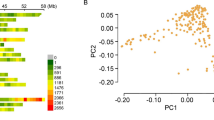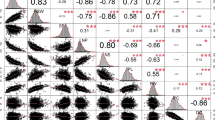Abstract
The red skin color desired by most apple consumers is not easy to achieve in warm climates, as the expression of MYB10, which regulates red pigmentation in apple, is influenced negatively by high temperatures. We describe the development and validation of a genetic marker for red skin coloration that effectively predicts color in a warm summer environment in Spain, as well as more temperate climates in New Zealand and Italy. Following the determination of a major-effect quantitative trait locus (QTL) controlling red skin coloration on linkage group (LG)9, using four segregating populations grown in New Zealand, and screened using the IRSC apple 8-K single-nucleotide polymorphism (SNP) array, the most significant SNP marker (ss475879531) was transformed into a marker suitable for use in a real-time PCR assay. This marker was validated using five apple seedling populations growing in a warm summer environment in Spain, demonstrating that the marker system efficiently predicts red skin coloration and can be used for marker assisted selection, even under conditions considered adverse for skin color development.




Similar content being viewed by others
References
Baudry A, Heim MA, Dubreucq B, Caboche M, Weisshaar B, Lepiniec L (2004) TT2, TT8, and TTG1 synergistically specify the expression of BANYULS and proanthocyanidin biosynthesis in Arabidopsis thaliana. Plant J 39:366–380
Chagne D, Carlisle CM, Blond C, Volz RK, Whitworth CJ, Oraguzie NC, Crowhurst RN, Allan AC, Espley RV, Hellens RP, Gardiner SE (2007) Mapping a candidate gene (MdMYB10) for red flesh and foliage colour in apple. BMC Genomics 8:11. doi:10.1186/1471-2164-8-212
Chagne D, Crowhurst RN, Troggio M, Davey MW, Gilmore B, Lawley C, Vanderzande S, Hellens RP, Kumar S, Cestaro A, Velasco R, Main D, Rees JD, Iezzoni A, Mockler T, Wilhelm L, Van de Weg E, Gardiner SE, Bassil N, Peace C (2012) Genome-wide SNP detection, validation, and development of an 8K SNP array for apple. PLoS ONE 7:12. doi:10.1371/journal.pone.0031745
Doyle JJ (1991) DNA protocols for plants. Springer Verlag, Berlin
Espley RV, Hellens RP, Putterill J, Stevenson DE, Kutty-Amma S, Allan AC (2007) Red colouration in apple fruit is due to the activity of the MYB transcription factor, MdMYB10. Plant J 49:414–427. doi:10.1111/j.1365-313X.2006.02964.x
Iglesias I, Echeverria G, Soria Y (2008) Differences in fruit colour development, anthocyanin content, fruit quality and consumer acceptability of eight “Gala” apple strains. Sci Hortic 119:32–40. doi:10.1016/j.scienta.2008.07.004
Kumar S, Chagne D, Bink MCAM, Volz RK, Whitworth C, Carlisle C (2012) Genomic selection for fruit quality traits in apple (Malus × domestica Borkh.). PLoS ONE 7. doi:10.1371/journal.pone.0036674
Kumar S, Raulier P, Chagné D, Whitworth C (2014) Molecular-level and trait-level differentiation between the cultivated apple (Malus × domestica Borkh.) and its main progenitor Malus sieversii. Plant Genet Resour
Lin-Wang K, Micheletti D, Palmer J, Volz R, Lozano L, Espley R, Hellens RP, Chagne D, Rowan DD, Troggio M, Iglesias I, Allan AC (2011) High temperature reduces apple fruit colour via modulation of the anthocyanin regulatory complex. Plant Cell Environ 34:1176–1190. doi:10.1111/j.1365-3040.2011.02316.x
Lozano L, Iglesias I, Micheletti D, Troggio M, Kumar S, Volz RK, Allan AC, Chagne D, Gardiner SE (2014) Feasibility of genome-wide association analysis using a small single nucleotide polymorphism panel in an apple breeding population segregating for fruit skin color. J Am Soc Hortic Sci 139:619–626
Souleyre EJF, Chagné D, Chen XY, Tomes S, Turner RM, Wang MY, Maddumage R, Hunt MB, Winz RA, Wiedow C, Hamiaux C, Gardiner SE, Rowan DD, Atkinson RG (2014) The AAT1 locus is critical for the biosynthesis of esters contributing to “ripe apple” flavour in “Royal Gala” and “Granny Smith” apples. Plant J 78:903–915. doi:10.1111/tpj.12518
Takos AM, Jaffe FW, Jacob SR, Bogs J, Robinson SP, Walker AR (2006) Light-induced expression of a MYB gene regulates anthocyanin biosynthesis in red apples. Plant Physiol 142:1216–1232. doi:10.1104/pp.106.088104
Telias A, Kui LW, Stevenson DE, Cooney JM, Hellens RP, Allan AC, Hoover EE, Bradeen JM (2011) Apple skin patterning is associated with differential expression of MYB10. Bmc Plant Biol 11. doi:10.1186/1471-2229-11-93
Zhu Y, Evans KM, Peace C (2010) Utility testing of an apple skin color MdMYB1 marker in two progenies. Mol Breed. doi:10.1007/s11032-010-9449-6
Acknowledgments
This work was funded by the New Zealand Ministry for Business Innovation and Employment (MBIE; Contract No. C06X0812) and PREVAR Ltd research consortium (Contract No. 26015), by the European Union funded project in the 7th Framework Programme: Marie Curie Actions, People International Research Staff Exchange Scheme (IRSES) proposals nº 230857 (REDHOTGEN) and nº 295146 (REDHOTGEN-2) and by Spain’s Instituto Nacional de Investigación y Tecnología Agraria y Alimentaria (INIA; project RTA 2009-00069-00-00). We thank Slipstream Automation Ltd. for providing the DNA extraction service.
Data archiving statement
The SNP accession numbers from the apple Infinium 8-K array were deposited into GenBank dbSNP. Marker validation data is shown in the supplementary material.
Author information
Authors and Affiliations
Corresponding author
Additional information
Communicated by E. Dirlewanger
Electronic supplementary material
Below is the link to the electronic supplementary material.
Supplemental Figure 1
Marker validation for red skin coloration in five apple families. The red coloration is expressed as anthocyanin concentration and intensity score. The parentage of the five populations is indicated in Supplemental Table 1 (PPTX 306 kb)
Supplemental Table 1
Parentage of the five families used for marker validation for red skin in apple (DOCX 12 kb)
Rights and permissions
About this article
Cite this article
Chagné, D., Kirk, C., How, N. et al. A functional genetic marker for apple red skin coloration across different environments. Tree Genetics & Genomes 12, 67 (2016). https://doi.org/10.1007/s11295-016-1025-8
Received:
Revised:
Accepted:
Published:
DOI: https://doi.org/10.1007/s11295-016-1025-8




